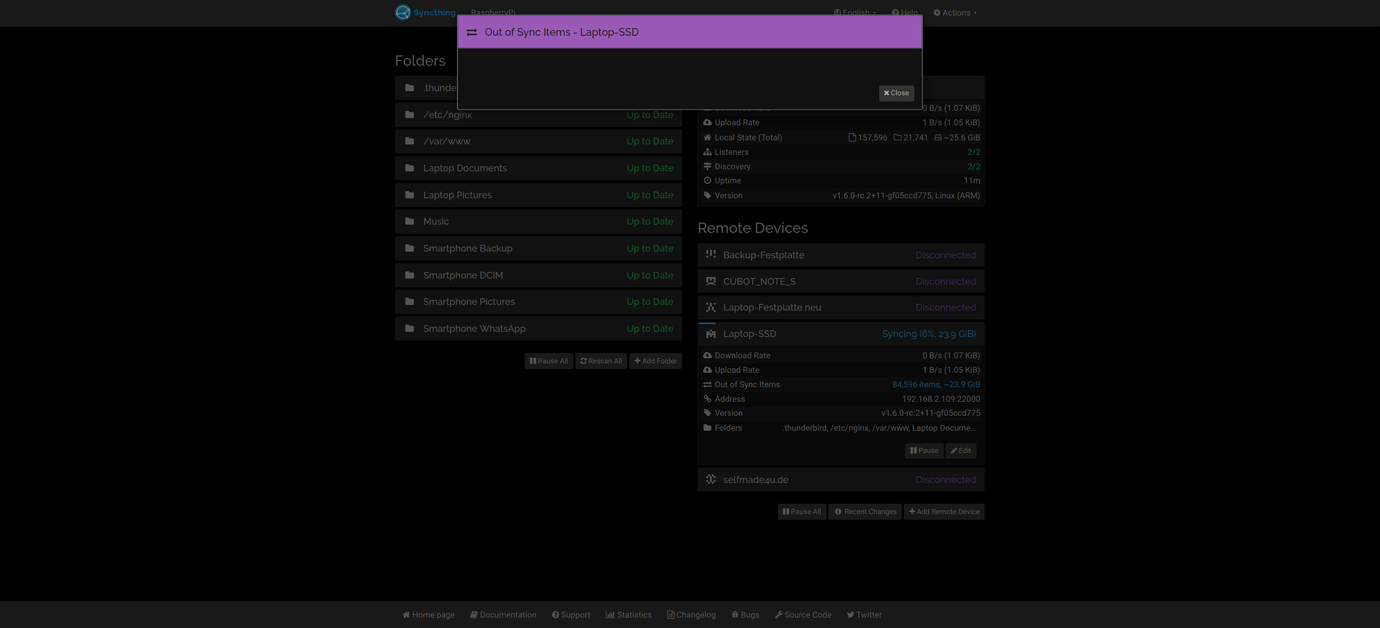
- #Syncthing one way sync android#
- #Syncthing one way sync software#
- #Syncthing one way sync code#
- #Syncthing one way sync Pc#
- #Syncthing one way sync plus#
Seafile looks pretty close, but the configuration and installation instructions are horrible, and every container I've tried to run has failed for some reason.
#Syncthing one way sync android#
Most syncing tools (Unison, rsync, etc) are not available as Android apps.Ī shared drive (CIFS, FTP) fails whenever the server is not available, which will be common since the server is on a LAN, and I'm not particularly thrilled by the security prospects of exposing something like that in a cloud service.

This violates my second requirement, which is to allow us to clear up space on the phones without having the server subsequently delete the files from the server. Syncthing fails here the authors have made it clear in tickets that this specific use case is not valid for Syncthing, and indeed they've hidden the "Ignore Deletes" option in an attempt to get people to stop using it. I'd like to automate the copying part, as that's the most tedious part I'd also like to get the photos on there, because right now they go into Google Photos, and we currently have to then log into Photos and manually download and copy those to the server. We buy digital music (e.g., Amazon MP3s, Bandcamp, Soundcloud) and put the music on the server, which we can then play from the media server. The use case is that I have a server on the LAN that has all of our music and photos on it, and an audio server connected to our home stereo. The client server must be an Android app (although Linux and OSX clients would be nice)
#Syncthing one way sync software#
The server software must be runnable on Linux There is no requirement to copy files from the server to the clientĬopying does not require user interaction (automatic) All of the solutions I've looked at have, so far, failed to satisfy at least one requirement.įiles put in a directory on the client are copied to the serverįiles removed from the client directory should be ignored (left on the server) If you’re looking for a secure, cross-platform and cloud-free way to keep computers in sync, then Syncthing is well worth trusting your data with.I'm looking for a one-way file sync similar to how Android handles photos.

If we’re being pernickety, it can be a bit slow syncing files, but given we’ve trusted it with keeping large media folders in sync for over three years now, it seems we’re sold. Once you’re familiar with it, Syncthing offers a great and convenient way to keep folders in sync with minimum security risk. By inputting this into your second device or computer, you can then create a link between them and choose which folders to sync between the two.
#Syncthing one way sync code#
Once up and running, whether through a GUI or your web browser, Syncthing is reasonably easy to configure: set up the folder or folders you wish to sync (various useful extras include support for file versioning), then make a note of your PC’s ID, an alphanumeric code similar to a product key.
#Syncthing one way sync plus#
There’s even an Android app, plus links to packages for Debian and Ubuntu. If that’s off-putting, then the main Syncthing website provides links to more user-friendly applications that combine the Syncthing backend with a graphical frontend, such as SyncTrazor (Windows), syncthing-macos (Mac) and Syncthing-GTK (cross-platform). Syncthing is basically a command-line tool – once downloaded and extracted, you launch it and then administer your shared folders through your web browser.

#Syncthing one way sync Pc#
So long as each PC is switched on and connected to the internet (or same local network), changes on one PC are replicated on the others – and because everything is encrypted and doesn’t reside in a centralised cloud folder, your data is as secure as it can be. This free and open-source solution uses P2P technology to directly link two or more devices – PCs, Macs, Android mobiles and even NAS drives – together through shared folders. Cloud storage like OneDrive is one option, but these come with limits to the amount of free storage as well as questions over the security of your data.Ī more secure option is Syncthing. One of the biggest challenges you’ll face is giving yourself easy access to the latest version of your files. These days, it’s increasingly common for people to find themselves working on more than one computer, or collaborating with others through remote shared folders.


 0 kommentar(er)
0 kommentar(er)
